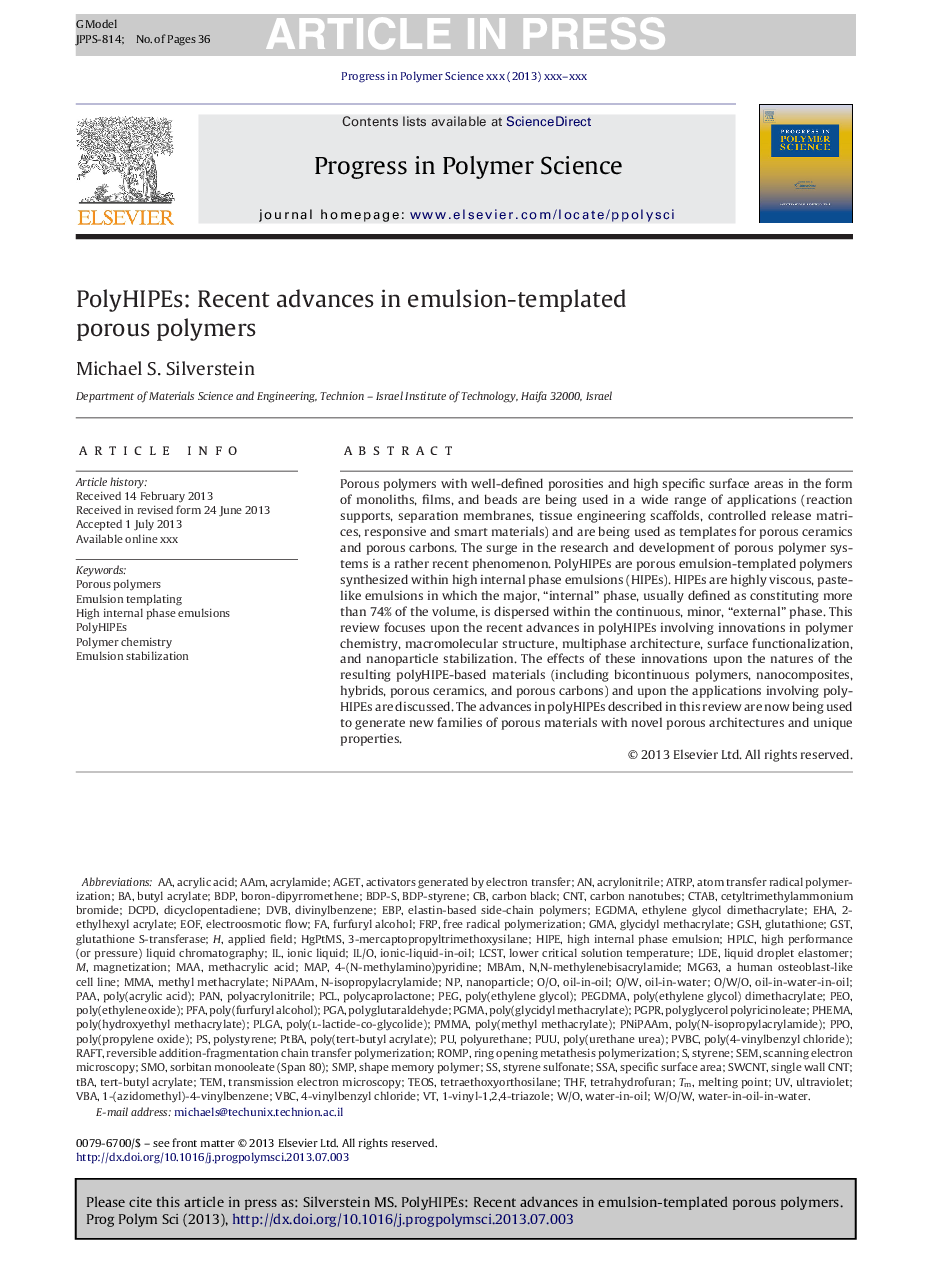| Article ID | Journal | Published Year | Pages | File Type |
|---|---|---|---|---|
| 5208179 | Progress in Polymer Science | 2014 | 36 Pages |
Abstract
Porous polymers with well-defined porosities and high specific surface areas in the form of monoliths, films, and beads are being used in a wide range of applications (reaction supports, separation membranes, tissue engineering scaffolds, controlled release matrices, responsive and smart materials) and are being used as templates for porous ceramics and porous carbons. The surge in the research and development of porous polymer systems is a rather recent phenomenon. PolyHIPEs are porous emulsion-templated polymers synthesized within high internal phase emulsions (HIPEs). HIPEs are highly viscous, paste-like emulsions in which the major, “internal” phase, usually defined as constituting more than 74% of the volume, is dispersed within the continuous, minor, “external” phase. This review focuses upon the recent advances in polyHIPEs involving innovations in polymer chemistry, macromolecular structure, multiphase architecture, surface functionalization, and nanoparticle stabilization. The effects of these innovations upon the natures of the resulting polyHIPE-based materials (including bicontinuous polymers, nanocomposites, hybrids, porous ceramics, and porous carbons) and upon the applications involving polyHIPEs are discussed. The advances in polyHIPEs described in this review are now being used to generate new families of porous materials with novel porous architectures and unique properties.
Keywords
PLGATEOSCTABPGAPCLN-IsopropylacrylamideCNTDVBDCPDSWCNTTHFATRPPAASSATBAPGPRGSHGSTEOFPPOMMAPFABDPMAAMG63EBPSMOGMAAAMpHEMAEGDMALDELcstPNIPAAmROMPEHAHIPEVBCPolyHIPEsVBADicyclopentadienePGMAPVBCN,N-methylenebisacrylamidePoly(l-lactide-co-glycolide)PolyglutaraldehydeApplied fieldO/W/OptBAactivators generated by electron transfer2-ethylhexyl acrylateMBAmoil-in-water-in-oil3-Mercaptopropyltrimethoxysilane4-vinylbenzyl chlorideO/WW/OW/O/Wwater-in-oilWater-in-oil-in-waterAcrylamidecetyltrimethylammonium bromideethylene glycol dimethacrylateStyreneStyrene sulfonateMethacrylic acidUltravioletFurfuryl alcoholHigh internal phase emulsionHigh internal phase emulsionsEmulsion templatingAtom transfer radical polymerizationAcrylonitrileAcrylic acidTemButyl acrylateBoron-dipyrrometheneTetrahydrofuranEmulsion stabilizationtert-butyl acrylateElectroosmotic flowRing opening metathesis polymerizationSMPLower critical solution temperaturedivinylbenzeneRAFToil-in-waterSpecific surface areaNIPAAmShape memory polymerPolymer chemistryFRPPANIonic liquidMMA, Methyl methacrylateSEMmagnetizationScanning electron microscopyTransmission electron microscopyNanoparticleCarbon nanotubesmapMelting pointPolyacrylonitrilePoly(N-isopropylacrylamide)Poly(furfuryl alcohol)Poly(urethane urea)Poly(propylene oxide)Poly(tert-butyl acrylate)Poly(methyl methacrylate)PMMApoly(hydroxyethyl methacrylate)Poly(glycidyl methacrylate)poly(ethylene oxide)Poly(ethylene glycol)Poly(ethylene glycol) dimethacrylatepoly(acrylic acid)Polycaprolactonepolyglycerol polyricinoleatePorous polymersReversible addition-fragmentation chain transfer polymerizationFree radical polymerizationPEGPolystyrenePolyurethanePEGDMAPEOAGETCarbon blackHPLCGlutathioneglutathione S-transferaseGlycidyl methacrylate
Related Topics
Physical Sciences and Engineering
Chemistry
Organic Chemistry
Authors
Michael S. Silverstein,
